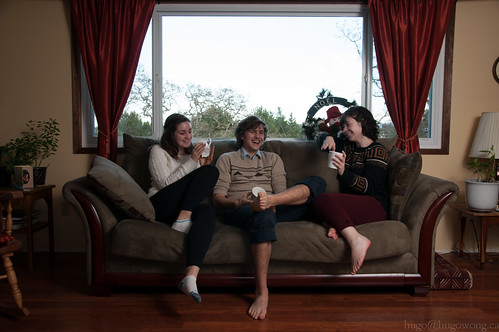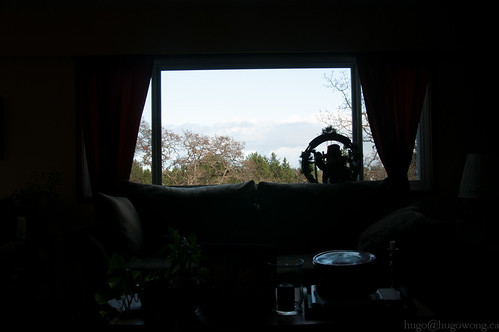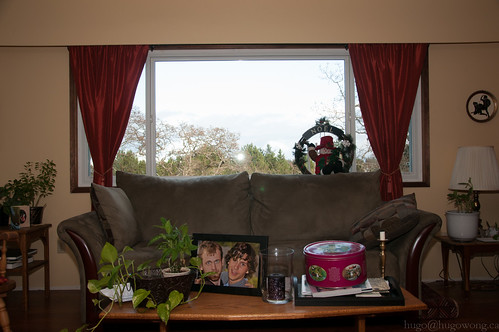This particular photo for the Martlet was to accompany a holiday-themed article about the company of friends during the Christmas season. So, in the Strobist spirit, here's the recipe for how I made it.
First, I began by setting my camera (in this case, a Nikon D300) into 14 bit uncompressed raw shooting mode. I almost never shoot in that mode, because the file sizes are far too large and it slows the camera down to 2.5 fps, making it unacceptable slow for press use. However, in studio-type situations, I find it gives me ultimate control over the look of the final image, and smoother transitions from highlight to shadow, which is an issue for a camera that uses a sensor that dates back to 2007. I know the debate over 12 versus 14 bit is just as fierce as the anti-UV filter debate (I'll have more to say on this later) or the JPEG versus RAW debate but I'll just say that I had the card space to spare and my lonely SB-600 needs time to recycle, so I really wasn't losing anything moving into 14-bit capture in this case.
As luck would have it, my subjects left the location for about 15 minutes to run a quick errand, so I had time to fiddle with my lights in a low-pressure situation. This was ideal as my subjects could step into my light setup without waiting for me to set up, which is a luxury I don't usually get.
When I first envisioned this shot, I thought I'd have them swaddled in blankets in front of a warm fire. I would have my back to the "fire" created with a heavily gelled speedlight, and that would light their faces. When I got there, however, I found that the background was less than ideal, and I'd need to use a very wide lens to capture my three subjects, making it somewhat unflattering. I've long been uncomfortable using wides, and the widest lens I have is only 27mm, so this idea was canned immediately. So, I began to improvise...
The couch by the window provided an interesting visual, as the couch was so large it seemed to swallow the people on it. The room was awash in autumnal colours, so I decided to include the warm and inviting colours in the photograph. Even the couch featured dark wood, so it all tied in. However, the window would be a technical concern, so this ruled out an available light exposure.
Since I didn't want the window to be blown out to pure white, I sacrificed the interior light to maintain an accurate reading of the sky, and used flash to cover my tracks. I only have a single flash, a Nikon SB-600, which I trigger using the built-in flash. Yes, I could have used manual radio triggering, but like Joe McNally, I've grown quite fond of line-of-sight triggering. The fact that you can back the power up and down from the camera is absolutely essential for me, as I don't have time to adjust individual lights myself, and I don't have assistants to do it for me.
With the flash bouncing off an Impact 60" umbrella in the 45-degree position at camera right (my usual default), I made a test exposure. I have no light meter, so I'm just fudging it with the LCD. I know I shouldn't, but I don't have the money to buy a Sekonic, so I get by.
I just gave it a try at 1/16 power or something, and it was woefully inadequate, so I upped the power to something like 1/2 power. This initial test highlighted some problems I'd need to overcome.
1. The commander pulse from my pop-up flash was reflecting in the window just above the centre line of the couch, which is one of downsides of using line-of-sight triggering. I'd need to position my tallest subject in the middle so his head could block the commander pulse.
2. While the room was lit reasonably well, there was not enough light falling onto the couch. Since I only had one light, I'd need to add some on-axis fill, perhaps with my butt-ugly $10 on camera flash mod that sort of looks like a dollar-store ring flash (if dollar stores sold photo mods, that is).
3. The UV filter on my camera (an entry-level multicoated Hoya) was causing flare problems, so I had to remove it. I usually keep my UV filter welded to the front element of my lenses because I don't use lens caps (takes too much time to remove) but in this controlled studio environment, I had to maximize my image quality, which meant removing it.
I tried to deescalate by simply using ceiling bounce flash, which gave me far more light than the umbrella solution, but the light was flat and shadowless, which was not what I wanted. So, I moved back to the umbrella solution.
With my head blocking the commander pulse (the biggest problem), I could take care of the rest. My subjects returned from their errand, I had worked out enough of the kinks to feel comfortable beginning to shoot. I could solve the rest of the issues on the fly. After all, I had no choice.


What was key to the picture was my subjects relationship with each other, so I just asked them to ignore me and just talk. The situation is quite artificial, so there was some awkwardness at first, but since they were my friends, and they already knew each other, it wasn't long before they started to get more comfortable. They had ample props to occupy themselves with, like mugs, oranges, and a cat. However, the cat left after one too many camera flashes.
With the camera on a tripod and mostly static subjects, I could set the camera to manual focus at f/5.6 and just press the shutter with my eye out of the finder so I could maintain eye contact with my subjects and keep the conversation light and fast. I never used to like tripods, but I may carry one around in the future just for this reason.
At some point, I decided to add the Interfit Strobies on-camera flash diffuser, which turns on camera flash into something resembling a ring light, but costs $10. It's the perfect mod for someone who just needs a pinch of on-axis fill, and doesn't care that it is incredibly stupid looking. I had my pop-up flash set manually to something like 1/16 power, and my SB-600 at something like 1/2 power (results may vary).
I was getting a few good frames, but at the suggestion of one of the subjects, I decided to remove the coffee table from the shot. I desperately wanted to include the strange yet charming photo on the coffee table, which was why I didn't remove it in the first place, but the table was a distraction in the foreground that had to go.


After I moved the table 15 minutes into the shoot, the photo was heavily simplified, which was a very good thing. The conversation also got a lot more spirited as my subjects relaxed. The expressions suddenly became a lot more genuine, and I took advantage of the moment by pushing them a little to laugh with faux-aggression, which isn't my usual modus operandi, but given my lack of credibility as an pushy, angry person (I think), it gave me the expression that I was looking for. Though it isn't advertised as such, photography often involves making a complete fool of yourself to try and get the shot.


After a few more frames, I called it a day. Total time: 24 minutes including setup.
POST PROCESSING
I have never been particularly good at post, and it's something I hope to rectify in the following months with the shiny new Kelby Training subscription and NAPP membership that I picked up on Cyber Monday. However, it's for a newspaper, so it's not like I can use very advanced forms of processing anyway.
One of the serious disadvantages of manually fudging exposure without a light meter is that you're at the mercy of the inaccuracy of the LCD. While I love the 921k dot screen on the back of my D300, and I have the LCD set the -1 brightness, my manual flash images are almost invariably one stop underexposed for some reason. So, one stop of positive EV is often the first thing I plug into Lightroom. The other problem I have is that Nikon raw files are dull and lifeless. I love Nikon ergonomics, but the files it produces just aren't as appetizing to me as the Canon ones are, at least SOOC (straight out-of-camera). Hence, some sharpening, mid-tone contrast, highlight recovery on the window (I still ended up blowing out some of the highlights there), a vignette to exaggerate what was already in the photo, a slight crop to remove the errant chair leg on the left of the frame (I should have moved it out in camera, but I didn't notice at the time) and the addition of some vibrance and saturation finished the job. I don't usually saturate images this much, but it was for newsprint, which usually robs an image of saturation given the gray paper, so I think it was warranted in this case.


Look for it inside this month's issue of the Martlet, on newsstands until January 10, 2013.


